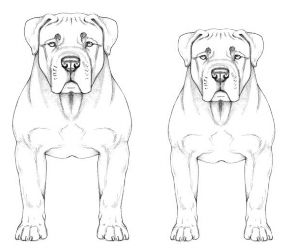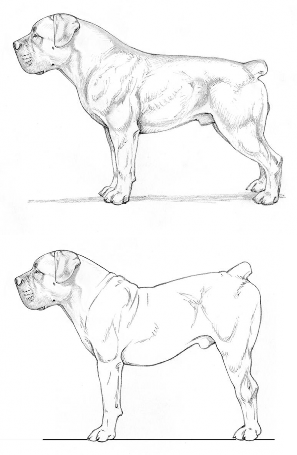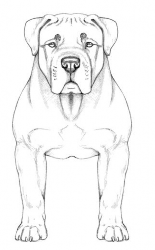
The Forelimbs
So much emphasis has been put on the hindquarters of the Boerboel for the past 30 years, with little regard for the rest of the dog. If you were to debate which is more important, the front or the rear drive train, you could quite easily build an overwhelming argument for the forelimbs. It is a little known fact, amongst all dog enthusiasts, that the front end of a dog is where most of the initial acceleration and power comes from. It is estimated that the front accounts for approximately 70 % of the dog’s power. This is verified by the dogs with excellent fronts and only average rears, out-performing dogs with excellent hindquarters and only average shoulder construction, in tasks which need quick acceleration and explosive power.
As soon as a dog begins to move, the dog’s head reaches forward and 70% of the dog’s entire bodyweight is on the forelimbs, with only the remaining 30% on the rear. When moving, the forelimbs need to be 2.3 times as strong as the hindquarters. When a Boerboel is standing, 60% of his weight is on the front legs and 40% on the back legs, so even when they are standing, the front end is taking 50% more weight than the rear. Taking the weight distribution and the original purpose of the Boerboel (which is to explode into action when danger is upon its owner) into consideration, it becomes clear that the front end is perhaps more important than the back end. That is only if we were to give preference to either the forelimbs or the hindquarters!

Front view, male and female Boerboel.
They both have a blocky head and body with wide chests and thick front legs. The females head chest and shoulders are smaller due to sexual dimorphism.
Are strong boned, with well-defined muscles and sturdy joints.
The bone on the front legs should be thick. Twelve inches or more, around the top of the forearm, is a good size for a male, 68cm tall. Large bones are usually attached to large sturdy joints. The reason for the large bone and sturdy joints is that Boerboels are very strong explosive dogs, so strong running gear is needed to keep everything together. Having thin legs on a Boerboel is like putting a V8 into a small, 4 cylinder car. When you use the power of the V8, components in the drive train of the 4 cylinder will begin to break.
Good muscling comes when the angles of the shoulder are correct. It is through correct angulation in the shoulder, and powerful muscles, that the explosive acceleration of a Boerboel can be generated.
There is a point where there is too much muscle or too much bone. That point is reached when the dog’s movement is compromised. I have seen dogs with too much muscle seem stiff and inflexible, but I have not yet seen a dog with so much bone that it impedes movement. Actually, at this moment in time, I personally think it is impossible to have a Boerboel with too much bone, and if it does exist, I would love to see that dog!
Should be correctly angulated from the well-sloped shoulder blade down to the metacarpus (pastern). Shoulder angulation is hard for the novice dog enthusiast to understand because it is all hidden by muscle and everything seems to blend in. The best way is to look where the top of the withers are and then draw an imaginary line down to the point of the shoulder, and then down to the front of the elbow. When you draw those two lines, you should have an obvious angle. Also, we can check if the point of the shoulder lines up with the brisket, and if the point of the elbow and the bottom of the brisket are at the same height off the ground. If the shoulder isn’t sloping enough, and the front shoulder angulation is too straight, then the above mentioned points will not line up.

Correct Vs incorrect shoulder Angulation
Incorrect front and rear angulation; notice how the top line of the dog is affected by both. It is impossible for a dog built like this to move well. Another side effect of such bad construction is bad stamina. This dog would fatigue quickly with the first signs being a wobbly, weak back end. If this were a bitch, she would have trouble delivering puppies naturally, because of the upward tilt of the pelvis.
Shoulder angulation effects musculature and more importantly, movement. Too much angulation in the front will cause the front to be weak and the dog will need to take more of its weight onto the rear. Not enough angulations in the shoulder doesn’t allow a dog to stretch out when running and it is less efficient for running at high speeds, so a dog with not enough angulation in the shoulder will fatigue quicker when running at top speed.
Should form a vertical line from the point of the shoulder down to the paws, with the elbows held close and parallel to the chest when viewed from the front.
Looking from the front, the dog’s shoulder construction and legs should line up with the feet. Any variation from being dead straight will effect the dog’s movement; the effect of misaligned legs on movement is proportional to how badly they stray from being straight.
Misaligned legs can, in many, but not all cases, put extra stresses on joints and bones. Dogs with turned-out feet and elbows quite often get sore elbows and wrists later in life, due to the uneven wearing on the joints.

Correct front view shows that shoulders, legs and feet are aligned, vertically, one on top of the other. This alignment allows joints and ligaments to work without undesirable stresses.
Seen from the side the forearm should be vertical from the elbow to the carpus. The metacarpus is short, thick and strong and angles very slightly forward.
The main thing to look out for here is the metacarpus or the ankle. If it is too low, it could be due to dietary deficiency. This problem can be fixed by supplementing the correct vitamins, minerals, and protein ratio needed, before the dog reaches the age of 8-9months. Sometimes it is genetics which causes the dog to be low in the pasterns/ metacarpus.
Once again, this will effect movement. The lower the carpus, the more it will effect the movement of the dog.
Another genetic trait to look out for, relating to the carpus and metacarpus, is the front feet turning out. This is a common trait in the Piona line and I believe it was a trait passed down from Donkheroek Kalpoot.
The forepaws point straight forward, are large, round, strongly boned and compact.
Ysterberg dogs were known for their straight, forward-pointing front feet. The feet need to be large and well boned to match the thick legs.
The toes are well arched, with curved black toenails and protected by hair in between. The pads are thick, tough and black.
Most Boerboels are too flat in the feet. A condition not helped by the fact that some are kept overweight by their owners. This can effect movement. A Boerboels toes/ feet should be like a cheetahs feet.
Cheetahs do not have retractable nails like the rest of the cat population, and their feet are a bit longer than the average cat. They are more like dog feet. So, like the cheetahs feet, the toes need to be tight and well arched. These tight feet help with the desired, buoyant movement.
Dogs with white pigmentation on their feet get foot sore very quickly when working and they also get foot sore on hot days when the ground heats up. I have often seen working Border Collies with one white foot, pick that foot up off the ground because it has become too tender, while the rest of the black pads keep on working throughout the day. Black pads are about five times tougher than white pads!
Breed Standard - The Legs & Feet Breed Standard - The Hindlimbs
